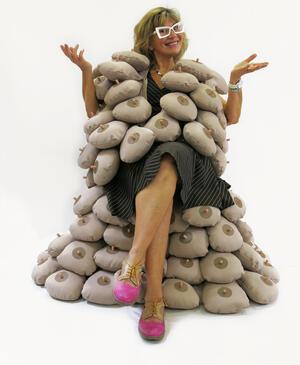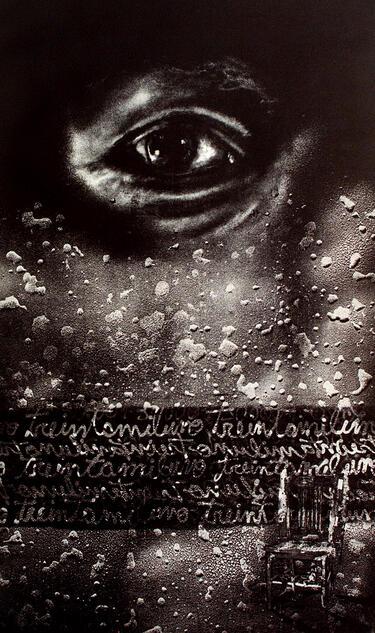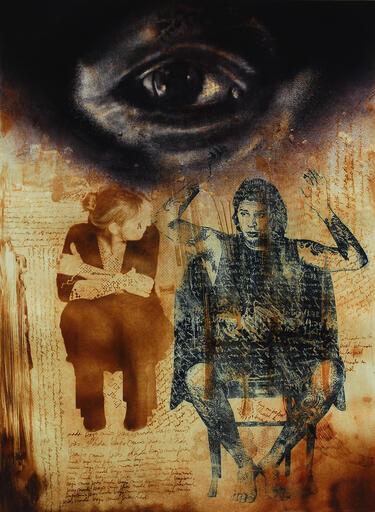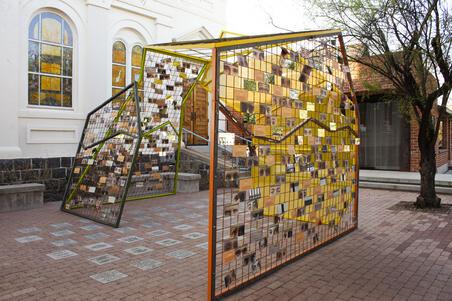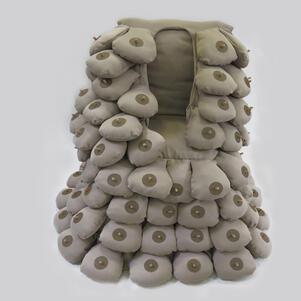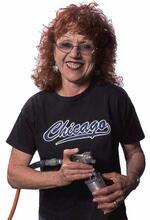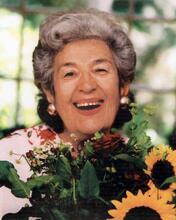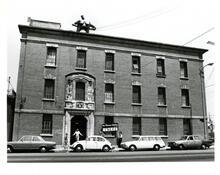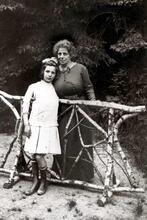Mirta Kupferminc
Born in Buenos Aires to survivors of Auschwitz, Mirta Kupferminc is an internationally recognized contemporary Argentine Jewish artist. For the past four decades, she has explored memory, culture, history, and language in a variety of art media, including painting, printmaking, sculpture, and etching. She interrogates her Jewish and Argentine roots to deal with themes of universal relevance that cross her entire oeuvre. Kupferminc creates motifs that become part of her iconography and uses them in different projects to explore multiple themes. She works regularly with Jewish and Argentine writers, has received the highest artistic distinction in Argentina, and regularly exhibits around the world.
“My work has a very strong mark of Judaism, but also a very strong mark of Argentinean identity.” Mirta Kupferminc to reporter, The Forward, 2009.
Mirta Kupferminc is an internationally recognized contemporary Argentine Jewish artist. For the past four decades, she has explored memory, culture, history, and language in a wide range of art media. Across her oeuvre, Kupferminc explores her Jewish and Argentine roots to deal with themes of universal relevance. She creates motifs that become part of her iconography, using them in different projects to explore multiple themes.
Childhood and Education
Mirta Kupferminc was born in Buenos Aires, on March 16, 1955, to Aron Kupferminc and Agnes Mandl Mero, both survivors of Auschwitz. Her experience as the daughter of immigrants and Holocaust survivors became one of the pillars of her work: “One of the most important events in my life took place before I was born” (Sadow, 2015).
Mirta and her older sister Margarita grew up in a multilingual home. Aron was Polish and Agnes Hungarian; they spoke German together, and strongly accented Spanish with the girls. They wanted their daughters to integrate into Argentine society.
At the ages of six and twelve, Mirta traveled with her family to visit survivor relatives in Hungary and Israel. They also visited Rome and Paris, exploring their main museums. Art and culture were highly valued in the Kupferminc home. Traveling at an early age and hearing multiple languages spoken at home gave her a different dimension of the world than many children received.
Wanting to study art, Kupferminc completed high school at the age of fifteen and was admitted to the Manuel Belgrano National Academy of Arts. She continued her studies at the National Academy of Fine Arts Prilidiano Pueyrredón and the National Academy of Higher Education in Fine Arts Ernesto de la Cárcova.
Argentine Identity
In her search to unite her Jewish and Argentine identities, Kupferminc addressed the relationship between the work of the Argentine writer J.L. Borges and the Kabbalah. The internationally renowned writer, who was not Jewish, used ancient rabbinical literature (A type of non-halakhic literary activitiy of the Rabbis for interpreting non-legal material according to special principles of interpretation (hermeneutical rules).midrash) and The esoteric and mystical teachings of JudaismKabbalah as sources for his literary work. In response to his mystical writings, Kupferminc produced a book for bibliophiles entitled Borges and the Kabbalah: Paths to the Word (2002) (Borges y la cabala: senderos del verbo), together with literature scholar Saul Sosnowski. They exhibited several times locally and internationally, and she created works in different media on the same theme.
The artist also explored recent Argentine history and memory through her work. On March 24, 1976, a military coup installed a civilian-military dictatorship in Argentina. During this time, the State carried out illegal repression, persecution, torture, and forced disappearance of people, as well as other forms of State terrorism. It is estimated that during this period the repressive forces made approximately 30,000 people disappear, until the restoration of democracy in 1983. On occasion of the 30th anniversary of the disappeared, Kupferminc created Thirtythousandandone (treintamiluno) (2005).
The title of this work suggests the need for the artist to add “one” in order to individualize the commemoration of the estimated 30,000 victims. At the bottom of the work, there is a chair with wings. We can understand that the "disappeared," far from being buried, were "vanished into thin air," and the empty chair with wings allows us to remember them, through the lack of the sitter. At the top of the same work, we see an eye. The open eye represents the idea of the observer, of being a witness. The role of witness is also central to Jewish tradition. The witnessing eye is also used as a symbol of connection with the cosmos and the universe.
Tattoos, Needles, and Hands
Kupferminc continued to explore different media and techniques. In The Skin of Memory (La piel de la memoria) (2007), exhibited at Centro Cultural Recoleta in Buenos Aires, she explored the relationship between ornamental tattoos and the numbered tattoo on her parents’ arms as Auschwitz survivors through a video installation and performance.
In 2009 Kupferminc had a major retrospective show in New York. Around this time, she also introduced embroidery into her work, by applying the traditional Hungarian needle craft to photographs of hands, actually embroidering the printed pictures. She addressed memory and migration and used the hand as a symbol of the path of life. This was not a new concept for Kupferminc, as she had begun in 1998 to work with hands in etchings surrounded by wandering characters, exhibited at the Taiwan Biennial. For Kupferminc the natural lines in the palm of her hand represent a journey of life, like a map, the artist’s own hand representing the territories of her life, where the Hungarian aesthetic embroidery and the tattooed prisoners numbers on her parents’ arms meet through the needle.
For the project Hand Written (Escrito a mano, 2009), Kupferminc photographed the hands of famous Jewish writers and produced a new body of work: paintings and etchings of each writer’s palm, overlaid by their texts. She worked with Israeli and Argentine writers Amos Oz, A. B. Joshua, Meir Shalev, Saul Sosnowski, Manuela Fingueret, and Eliahu Toker, as well as her own hand with a text by Borges.
Other Projects
Argentine Jewish artist Mirta Kupferminc’s Clamor in the Desert, a sukkah at the Jewish History Museum in Tucson, Arizona, 2020. Site specific installation, 4 m x 4.5 m x 5 m. Wire mesh, perforated metal plate, metal tube; 300 printed eyes and 100 printed texts of the Universal Human Rights Declaration in 50 languages. Courtesy of Mirta Kupferminc.
In 2012 Kupferminc received the National Prize, the highest artistic distinction in Argentina. The following year she was the first international art fellow at LABA, A Laboratory of Jewish Culture, in New York, where she created a series of works related to feminism and motherhood entitled EVE: Chair of all mothers (Eva: la madre primordial), S-Naked (Transformado en serpiente), and Divine Desire (Divino deseo). In 2015, she launched LABA Buenos Aires, allowing exchange between artists working on similar themes at different locations around the world.
In 2017 Kupferminc represented Argentina in the Jerusalem Biennial with her installation Traduttore-Tradittore (Translator-Traitor), in which she addressed the Biblical story of the Tower of Babel as the birth of otherness. The piece included hand-cut rubber letters of different alphabets and the story of the Tower of Babel in 70 languages. In 2019, Kupferminc curated the group exhibition “Confrontation/Conversation” by eighteen Argentine Jewish and non-Jewish artists who exhibited at the Jerusalem Biennial.
In 2018 Marianne Hirsch invited Kupferminc to join the international working group Women Mobilizing Memory, in which Kupfemrinc explores the relationship between memory and being a woman artist. Together with Hirsch and Spitzer, she developed the series Bearing Witness (2019), in which she addresses photography as a means of resistance and pays tribute to Mendel Grossman, a clandestine photographer from the Lodz Ghetto.
Mirta Kupferminc lives in Buenos Aires with her husband Kurt Frieder. She creates and teaches art in her workshop, mentors artists through the project Grafica Insurgente, and leads the LABA-BA study group together with Tova Shvartzman. She continues to exhibit nationally and internationally, participates in international conferences, and lectures about her work.
Selected Artworks by Mirta Kupferminc
Memory (1989); Homage in memory of the victims of AMIA (1996); On the Way (2001); Borges and the Kabbalah: Paths of the Word (2006); Treintamiluno (2005); Four Entered Paradise (2006); The Skin of Memory (2007); Embroidered onto the Skin of Memory (2009); En la Palma de mi mano (2011); Hand Written (2012); EVE: Chair of all mothers (2014); S-Naked (2015); Divine Desire (2014); Traduttore-Tradittore (2017); Bearing Witness – Tribute to Mendel Grossman (testimony for the witness) (2019).
Apel, Dora. Memory Effects: The Holocaust and the Art of Secondary Witnessing. New Brunswick, NJ: Rugters University Press, 2002.
Goldfine, Daniela. "Deshilando el entramado de la memoria en el arte de Mirta Kupferminc." Ámbitos Feministas 2.2 (Fall 2012): 59-75.
Hirsch, Marianne and Leo Spitzer. “Las rutas sin raíces de Mirta Kupferminc.” In Wanderings, exh. cat., Hebrew Union College Jewish Institute of Religion Museum, 2009.
Kohn, Tamara. “Migración, memoria y tikun olam en la obra de la artista judeo-argentina Mirta Kupferminc.” Cuadernos Judaicos 29 (December 2012).
Kohn, Tamara. Interviews with Mirta Kupferminc, December 30, 2010, September 2019, October 2019.
Kruger, Laura. Wanderings, exh. cat., Hebrew Union College-Jewish Institute of Religion Museum, 2009.
Kupferminc, Mirta, "¿Artista o artista judio? Su singularidad," In Recreando la Cultura Judeoargentina: Literatura y Artes Plasticas, edited by Ricardo Feierstein and Stephen Sadow. Mila Ensayos, 2003.
Mirta Kupferminc’s website: www.mirtakupferminc.net
Musleah, Rachel. “The Arts: Multimedia Ghosts.” Hadassah Magazine, April/May, 2010.
Orden, Erica. “Building Identity Through Art.” The Forward, November 18, 2009.
Ran, Amalia and Jean Cahan. Returning to Babel: Jewish Latin American Experiences, Representations, and Identity. Leiden, Boston: Brill, 2011.
Sadow, Stephen. “Argentine-Jewish Interdisciplinary Artist.” In jewishlatinamerica. April 6, 2018. https://jewishlatinamerica.wordpress.com/2018/04/06/mirta-kupferminc/

